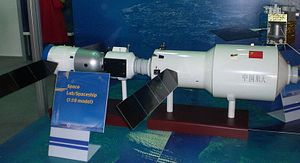On Sunday, Chang’e-3 completed China’s first soft-landing on the moon. A few hours later, China’s first moon rover, Yutu (Jade Rabbit), successfully separated from the lander.
Yutu’s mission is only a part of China’s ambitious space program, which has received a huge amount of capital and personnel investments in the past decades. In a China Central Television simulcast, the host and chief designers of the Chang’e project explained and discussed the whole procedure in a 3-D studio simulation. During the program, they tried to underline the technological complexity of this project as well as its historic significance. With the successful soft-landing and operation of Yutu rover, the CCTV narrator said emotionally that China is now the third country (after the Soviet Union and the U.S.) to have achieved soft-landing on another astronomical body. The successful soft-landing of Chang’e-3 and the images sent back to earth by Yutu rover may give the Chinese excitement, pride, and perhaps even a distraction from the on-going tensions in East China Sea.
China has indeed made a rather astonishing progress in the aerospace industry during the past decades, and is now recognized as an important player in outer space. There can be many reasons to explain how China could have made such advances within a few decades. However, there is an interesting phenomenon that stands out: on average, aerospace technician teams in China and much young than their counterparts in Russia, and the US. According to Yang Baohua, President of China Academy of Space Technology (CAST), technicians in Chinese aerospace teams are mostly in their early 30s. The average age of the whole Chang’e-3 project personnel team, for example, is 32.4. By contrast many Russian and American technicians are in their 60s or 50s.
With its growing economic power, China can provide virtually endless capital investments into the aerospace industry, attracting young professionals into a number of simultaneous aerospace projects. Though there are suspicions in the West that China may have acquired some of its hi-tech equipment through industrial espionage, we should not ignore the fact that China launched and successfully accomplished its nuclear, missile, and satellite programs in the extremely difficult blockade era when the Soviet Union ceased to provide China’s only support.
In the photos that the Yutu rover and Chang’e-3 take of each other, people will clearly see China’s national flag symbolically pictured in the background of the Bay of Rainbows, which no other probes and rovers have ever touched upon. As the sign of our times, countries always do this and China is no exception.
Give the progresses China has made in the fields of rocket technologies and aerospace science, particularly in the past ten years, what kind of role will China play in space and how far will Chinese probes and rovers go?
In the most recent White Paper on China’s Space Activities, released by the Information Office of the State Council in December 2011, China announced major tasks for the next five-year period (2012-2017): space transportation systems, man-made earth satellites, human spaceflight, deep-space exploration, space launch sites, and so on. Obviously, China’s aerospace industry has been developing in a systematically designed pattern that enables Chinese probes, though not going too far, to travel fast enough to surprise the world. As the Yutu rover explores the moon’s surface, Chang’e-2, a previously launched probe, is travelling into the deep space. Chang’e-2 is sending signals back to Earth from more than 65 million kilometers away, and it is still traveling.
Aerospace science also calls for cooperation. In the recent sci-fi movie Gravity, China’s space station “Tian Gong” saved the main character’s life, although it, like the U.S. spacecraft, did not survive in the deadly accident. This does not necessarily imply that China is a savior, but may tell us a truth about how vulnerable and fragile we are in a total disaster and how important it is to join hands with each other. Hence while China holds to its rights to freely explore outer space, it is also involved in bilateral and multilateral international exchanges and cooperation in major fields such as space science research, applications for satellites, space labs and space stations, and of course commercial satellite launch services.
With Chang’e-3 and the Yutu rover on the moon, we can see the larger picture of the Chinese dream. With the knowledge and skills of its young aerospace technicians, China’s exploration into space will be going much further in coming years. However, China should also work wisely and skillfully with its neighbors and other countries to find solutions to various disputes and conflicts that it is involved in. China’s rise on Earth must be peaceful, since here is where all dreams and journeys start.

































